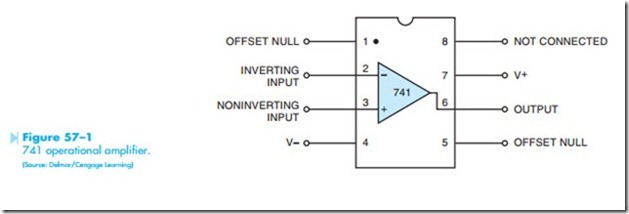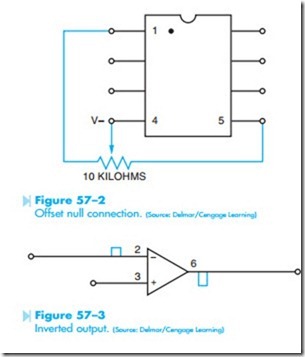The Operational Amplifier
The operational amplifier has become another very common component found in industrial electronic circuits. The operational amplifier, or op amp as it is generally referred to, is used in hundreds of different applications. There are different types of op amps used, depending on the type of circuit it is intended to operate in. Some op amps use bipolar transistors for the input and others use field effect transistors. The advantage of using field effect transistors is their extremely high input impedance, which can be several thousand megohms. The advantage of this extremely high input impedance is that it does not require a large amount of current to operate the amplifier. In fact, op amps, which use FET inputs, are generally considered as requiring no input current.
THE IDEAL AMPLIFIER
Before continuing the discussion of op amps, it should first be decided what an ideal amplifier is. First, the ideal amplifier should have an input impedance of infinity. If the amplifier had an input impedance of infinity, it would require no power drain on the signal source being amplified. There- fore, regardless of how weak the input signal source is, it would not be affected when connected to the amplifier. The ideal amplifier would have 0 output impedance. If the amplifier had 0 output imped- ance it could be connected to any load resistance desired and not drop any voltage inside the amplifier. If it had no internal voltage drop, the amplifier would utilize 100% of its gain. Third, the amplifier would have unlimited gain. This would permit it to amplify any input signal as much as desired.
741 PARAMETERS
There is no such thing as the ideal or perfect amplifier of course, but the op amp can come close. One of the old reliable op amps, which is still used to a large extent, is the 741. The 741 will be used in this description as a typical operational amplifier. Please keep in mind that there are other op amps that have different characteristics of input and output impedance, but the basic theory of operation is the same for all of them.
The 741 op amp uses bipolar transistors for the input. The input impedance is about 2 megohms, and the output impedance is about 75 ohms. Its open loop or maximum gain is about 200,000. Actually, the 741 op amp has such a high gain that
it is generally impractical to use and negative feed- back, which will be discussed later, is used to reduce the gain. For instance, assume the amplifier has an output voltage of 15 volts. If the input signal voltage is greater than 1/200,000 of the output voltage or 75 microvolts (15/200,00 = .000075), the ampli- fier would be driven into saturation at which point it would not operate.
741 PIN CONNECTION
The 741 operational amplifier is generally housed in an 8-pin in-line IC package, Figure 57–1, Pins #1 and #5 are connected to the offset null. The offset null is used to produce 0 volts at the output. What happens is this: The op amp has two inputs called the inverting input and the noninverting input. These inputs are connected to a differential amplifier that amplifies the difference between the two voltages. If both of these inputs are connected to the same voltage, say by grounding both inputs, the output should be 0 volts. In actual practice, however, there are generally unbalanced conditions in the op amp that cause a voltage to be produced at the output. Because the op amp has a very high gain, a very slight imbalance of a few microvolts at the input can cause several millivolts at the output. The offset nulls are adjusted after the 741 is connected into a working circuit. Adjustment is made by connecting a 10K ohm potentiometer across pins #1 and #5, and connecting the wiper to the negative voltage, Figure 57–2.
Pin #2 is the inverting input. If a signal is applied to this input, the output will be inverted. For instance, if a positive-going AC voltage is applied
to the inverting input, the output will produce a negative-going voltage, Figure 57–3.
Pin #3 is the noninverting input. When a sig- nal voltage is applied to the noninverting input, the output voltage will be the same polarity. If a positive-going AC signal is applied to the noninvert- ing input, the output voltage will be positive also, Figure 57–4.
Pins #4 and #7 are the voltage input pins. Operational amplifiers are generally connected to above- and below-ground power supplies. These power supplies produce both a positive and negative voltage as compared to ground. There are some circuit connections that do not require an above- and below-ground power supply, but these are the
exception instead of the rule. Pin #4 is connected to the negative- or below-ground voltage and pin #7 is connected to the positive- or above-ground voltage. The 741 will operate on voltages that range from about 4 volts to 16 volts. Generally, the operating voltage for the 741 is 12 to 15 volts plus and minus. The 741 has a maximum power output rating of about 500 milliwatts. Pin #6 is the output and pin #8 is not connected.


